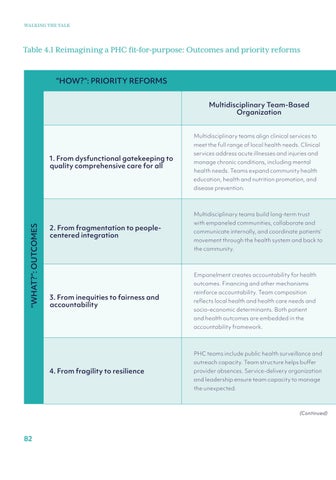WALKING THE TALK
Table 4.1 Reimagining a PHC fit-for-purpose: Outcomes and priority reforms “HOW?”: PRIORITY REFORMS Multidisciplinary Team-Based Organization Multidisciplinary teams align clinical services to meet the full range of local health needs. Clinical
1. From dysfunctional gatekeeping to quality comprehensive care for all
services address acute illnesses and injuries and manage chronic conditions, including mental health needs. Teams expand community health education, health and nutrition promotion, and disease prevention.
“WHAT?”: OUTCOMES
Multidisciplinary teams build long-term trust
2. From fragmentation to peoplecentered integration
with empaneled communities, collaborate and communicate internally, and coordinate patients’ movement through the health system and back to the community.
Empanelment creates accountability for health outcomes. Financing and other mechanisms
3. From inequities to fairness and accountability
reinforce accountability. Team composition reflects local health and health care needs and socio-economic determinants. Both patient and health outcomes are embedded in the accountability framework.
PHC teams include public health surveillance and outreach capacity. Team structure helps buffer
4. From fragility to resilience
provider absences. Service-delivery organization and leadership ensure team capacity to manage the unexpected.
(Continued)
82


